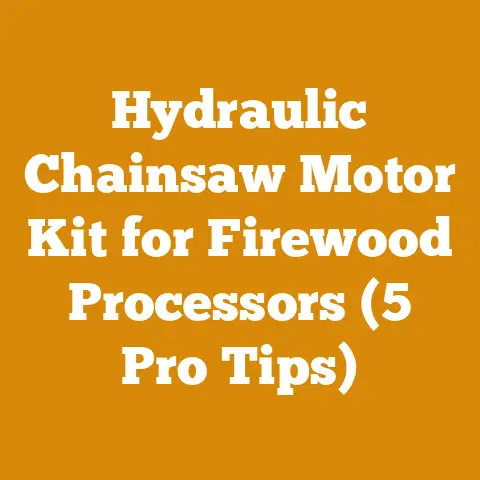How Is Firewood Sold? Best Times & Tips for More Sales (Pro Woodwork)
How Is Firewood Sold? Best Times & Tips for More Sales (Pro Woodwork)
The crackling warmth of a wood-burning stove or fireplace on a cold winter’s night is a timeless comfort. But behind that cozy scene lies a complex market, a network of individuals and businesses working hard to bring that firewood to your hearth. If you’re considering entering the world of firewood sales, whether as a small-scale side hustle or a more serious venture, understanding the nuances of how firewood is sold, when to sell, and how to maximize your profits is crucial. As someone who’s spent years felling trees, splitting wood, and managing my own little firewood operation, I’ve learned a thing or two about navigating this sometimes-tricky landscape. Let’s dive in!
Understanding the Firewood Market: Resale Value and Beyond
The first thing to consider is the potential resale value of your firewood. What are people in your area willing to pay for a cord of seasoned oak? What about a mix of softer woods like pine or poplar? The answer to these questions will dictate your pricing strategy and, ultimately, your profitability.
Firewood isn’t just about heating homes anymore; it’s about ambiance, outdoor cooking, and even landscaping. Understanding these different needs allows you to tailor your offerings and command a better price.
How Firewood is Sold: Units of Measurement and Pricing Structures
Firewood isn’t sold like apples or oranges; there are specific units of measurement that are commonly used, and understanding them is paramount.
The Cord: The Industry Standard
The most common unit of measurement for firewood is the cord. A legal cord, as defined by the National Institute of Standards and Technology (NIST), is a neatly stacked pile of wood measuring 4 feet high, 4 feet wide, and 8 feet long, totaling 128 cubic feet. It’s important to note that this includes air space between the pieces of wood.
- Full Cord: As described above.
- Face Cord (or Rick): This is where things can get confusing. A face cord, sometimes called a rick, is a stack of wood that is 4 feet high and 8 feet long, but the width is whatever the seller chooses. This is often the length of the firewood pieces themselves, typically 16 inches. Because the width is variable, the volume of a face cord is not standardized and can be misleading. A face cord is often advertised as a “cord” to the unaware buyer. Always clarify the dimensions when buying or selling a face cord. A face cord with 16-inch wood is one-third of a full cord.
- Loose Cord: This is a less common measurement, but it refers to a cord of wood that is not neatly stacked. The volume is still supposed to be 128 cubic feet, but it’s harder to verify.
Other Units of Measurement
- Bundle: Bundles are smaller amounts of firewood, typically sold at gas stations, grocery stores, and campgrounds. They usually contain a few pieces of wood and are priced individually.
- Bag: Similar to bundles, bags of firewood are often sold at retail locations. The size and price vary widely.
- Cubic Foot: While less common for firewood, cubic feet might be used for smaller quantities or when selling wood scraps for kindling.
Pricing Structures: Factors Affecting the Cost of Firewood
The price of firewood is influenced by a multitude of factors. Understanding these factors will help you price your firewood competitively and profitably.
- Wood Species: Hardwoods like oak, maple, and hickory generally command higher prices than softwoods like pine, poplar, and fir. This is because hardwoods burn hotter and longer, providing more heat per unit volume.
- Seasoning: Seasoned firewood, which has been dried for at least six months to a year, is more expensive than green (freshly cut) wood. Seasoned wood burns more efficiently, produces less smoke, and is easier to light. The moisture content should be below 20% for optimal burning.
- Cutting and Splitting: Firewood that is already cut and split is more convenient for the buyer and therefore fetches a higher price.
- Delivery: Delivery adds to the cost of firewood, especially if the delivery location is far from the seller’s yard.
- Location: Firewood prices vary significantly depending on location. Areas with colder climates and a higher demand for firewood will generally have higher prices.
- Competition: The level of competition in your area will also influence your pricing. If there are many firewood sellers, you may need to lower your prices to attract customers.
- Quantity: Buying in larger quantities, such as a full cord, usually results in a lower price per unit volume compared to buying smaller amounts like bundles or bags.
- Presentation: Neatly stacked and well-presented firewood can command a higher price.
- Demand: Demand is highest during the fall and winter months, leading to higher prices.
Data Points and Statistics:
- According to the USDA Forest Service, the average price of a cord of firewood in the United States ranges from $150 to $500, depending on the factors mentioned above.
- A 2023 report by Statista estimates the US firewood market size to be around $3 billion.
- Prices in urban areas are generally higher than in rural areas due to higher transportation costs and greater demand.
Personal Story:
I remember one winter when I was just starting out. I had a good supply of seasoned oak, but the market was flooded with cheaper, green wood. I decided to focus on the quality of my product, emphasizing the higher BTU content and cleaner burn of seasoned oak. I also offered free delivery within a certain radius. It worked! People were willing to pay a premium for the assurance of quality and convenience.
Breaking Down the Cost Components: My Firewood Operation
Let’s delve into the cost components that go into producing and selling firewood. This is based on my own experiences and observations, and the numbers can vary greatly depending on your specific circumstances.
-
Timber Purchase or Harvesting Costs: This is the cost of acquiring the raw wood. If you’re buying logs from a logging company, the price will depend on the species, quality, and volume. If you’re harvesting your own timber, you’ll need to factor in the cost of permits (if required), fuel for your chainsaw, and the time spent felling the trees.
- Timber Prices: Timber prices fluctuate based on market conditions. According to Forest2Market, in Q3 2023, the average price for hardwood sawtimber in the Southeast US was around $30 per ton. Prices vary widely by species and region.
- Harvesting Costs: This can vary greatly. Felling a tree and bucking it into manageable logs can take anywhere from 30 minutes to several hours, depending on the size and species of the tree. Factoring in your hourly rate (or the hourly rate of your logging crew) and the cost of fuel and chainsaw maintenance is crucial.
- My Experience: I usually budget around $50-$100 per cord for timber acquisition, whether I’m buying logs or harvesting my own. This includes permits, fuel, and a portion of my time.
-
Tool Costs: Chainsaws, wood splitters, axes, wedges, and safety equipment are essential for firewood production.
-
Chainsaw: A good quality chainsaw can cost anywhere from $300 to $1,000 or more. Maintenance costs include bar oil, chain sharpening, and occasional repairs.
- Data Point: A professional-grade chainsaw might require $50-$100 in annual maintenance.
- Wood Splitter: A hydraulic wood splitter can significantly increase your efficiency. Prices range from $1,000 for a small electric splitter to $5,000 or more for a larger gas-powered model.
- Data Point: Renting a wood splitter can cost $50-$100 per day.
- Axes and Wedges: These are essential for splitting larger pieces of wood. A good quality axe can cost $50-$100.
- Safety Equipment: This includes a helmet with a face shield, ear protection, chaps, and gloves. Budget around $200-$300 for safety gear.
- My Experience: I’ve found that investing in quality tools pays off in the long run. A good chainsaw will last for years with proper maintenance, and a hydraulic wood splitter can save you countless hours of back-breaking labor. I budget around $500 per year for tool maintenance and replacement.
-
Labor Costs: If you’re hiring help to cut, split, and stack firewood, you’ll need to factor in labor costs.
-
Wage Rates: Labor rates vary depending on your location and the experience of the worker. The average hourly wage for a general laborer in the US is around $15-$20.
- Productivity: A skilled firewood handler can typically process 1-2 cords of wood per day.
- My Experience: When I hire help, I pay around $18 per hour. I factor in about 8 hours of labor per cord, which includes cutting, splitting, stacking, and loading. This translates to about $144 in labor costs per cord.
-
Transportation Costs: This includes the cost of fuel, vehicle maintenance, and insurance for your truck or trailer.
-
Fuel Costs: Fuel costs fluctuate, but you can estimate your fuel consumption based on the distance you’re traveling and the fuel efficiency of your vehicle.
- Vehicle Maintenance: Regular maintenance is essential to keep your vehicle running smoothly. Budget for oil changes, tire rotations, and other repairs.
- Insurance: Make sure you have adequate insurance coverage for your vehicle and trailer.
- My Experience: I use a pickup truck and trailer to deliver firewood. I estimate my transportation costs to be around $20-$30 per cord, depending on the distance.
-
Drying and Storage Costs: Firewood needs to be properly dried and stored to prevent rot and ensure optimal burning.
-
Drying Time: The drying time for firewood varies depending on the species, climate, and stacking method. Hardwoods typically take 6-12 months to dry, while softwoods can dry in 3-6 months.
- Storage Costs: You’ll need a dry and well-ventilated space to store your firewood. This could be a shed, a tarp-covered stack, or even just a sunny spot in your yard.
- My Experience: I stack my firewood in rows, allowing for good air circulation. I cover the top of the stack with a tarp to protect it from rain and snow. I estimate my drying and storage costs to be minimal, as I use existing space in my yard.
-
Marketing and Advertising Costs: To sell your firewood, you’ll need to let people know you’re in business.
-
Online Advertising: Online platforms like Craigslist, Facebook Marketplace, and local classifieds can be effective ways to reach potential customers.
- Print Advertising: Local newspapers and flyers can also be used to advertise your firewood.
- Word-of-Mouth: Encourage your existing customers to spread the word about your business.
- My Experience: I rely heavily on word-of-mouth and online advertising. I post ads on Craigslist and Facebook Marketplace, and I encourage my customers to refer their friends and neighbors. I spend around $50 per month on advertising.
Calculating Your Costs: A Practical Example
Let’s say I’m selling seasoned oak firewood in my local area. Here’s a breakdown of my estimated costs per cord:
- Timber Acquisition: $75
- Tool Maintenance: $25
- Labor: $144
- Transportation: $25
- Drying and Storage: $0 (using existing space)
- Marketing and Advertising: $5
Total Cost Per Cord: $274
To make a profit, I need to sell my firewood for more than $274 per cord. If the market price for seasoned oak in my area is $350 per cord, I can make a profit of $76 per cord.
Best Times to Sell Firewood: Capitalizing on Seasonal Demand
Timing is everything in the firewood business. Demand fluctuates throughout the year, and understanding these patterns is crucial for maximizing your sales and profits.
Peak Season: Fall and Winter
The peak season for firewood sales is undoubtedly the fall and winter months. As temperatures drop and people start firing up their fireplaces and wood stoves, demand for firewood skyrockets.
- October-December: This is the busiest time of year. People are stocking up for the winter, and you can often command the highest prices.
- January-February: Demand remains strong during these months, especially in areas with harsh winters.
Off-Season: Spring and Summer
The spring and summer months are typically the off-season for firewood sales. Demand is low, and prices are often lower. However, this can also be a good time to build up your inventory and prepare for the upcoming peak season.
- March-May: This is a good time to harvest and split wood, allowing it to season over the summer.
- June-August: Demand is at its lowest during these months. Consider offering discounts or running promotions to attract customers.
Strategies for Year-Round Sales
While demand is highest during the fall and winter, there are ways to generate sales throughout the year.
- Early Bird Specials: Offer discounts to customers who purchase firewood early in the season.
- Summer Bundles: Sell smaller bundles of firewood for campfires and outdoor cooking.
- Kiln-Dried Firewood: Kiln-dried firewood is ready to burn immediately and can be sold year-round.
- Partner with Campgrounds: Supply firewood to local campgrounds during the summer months.
Personal Story:
I learned the importance of timing the hard way. One year, I waited too long to start cutting and splitting wood. By the time the peak season arrived, I was scrambling to keep up with demand. I missed out on potential sales and had to work long hours to catch up. Now, I start preparing for the winter months well in advance, ensuring I have a good supply of seasoned firewood ready to go.
Tips for More Firewood Sales: Standing Out from the Crowd
In a competitive market, it’s important to differentiate yourself and offer something that sets you apart from the competition.
Quality Matters: Seasoned Wood is Key
As I’ve emphasized throughout this article, seasoned firewood is far superior to green wood. It burns hotter, produces less smoke, and is easier to light. Make sure your firewood is properly seasoned before you sell it.
- Moisture Content: Use a moisture meter to check the moisture content of your firewood. Aim for a moisture content of 20% or less.
- Proper Stacking: Stack your firewood in rows, allowing for good air circulation.
- Weather Protection: Cover the top of the stack with a tarp to protect it from rain and snow.
Customer Service: Building Relationships
Providing excellent customer service is crucial for building a loyal customer base.
- Be Responsive: Respond promptly to inquiries and orders.
- Be Reliable: Deliver your firewood on time and as promised.
- Be Friendly: Treat your customers with respect and courtesy.
- Offer a Guarantee: Stand behind your product and offer a satisfaction guarantee.
Value-Added Services: Going the Extra Mile
Consider offering value-added services to attract customers and increase your profits.
- Delivery: Offer delivery to your customers’ homes.
- Stacking: Stack the firewood for your customers upon delivery.
- Kindling: Include a bundle of kindling with each order.
- Fire Starters: Sell fire starters to make it easier for your customers to light their fires.
- Custom Cutting: Offer custom cutting services to meet your customers’ specific needs.
Marketing and Advertising: Spreading the Word
Effective marketing and advertising are essential for reaching potential customers.
- Online Presence: Create a website or social media page to showcase your firewood and services.
- Local Advertising: Advertise in local newspapers, flyers, and community newsletters.
- Word-of-Mouth: Encourage your existing customers to refer their friends and neighbors.
- Partnerships: Partner with local businesses to promote your firewood.
Pricing Strategies: Finding the Sweet Spot
Finding the right price for your firewood is crucial for maximizing your profits.
- Research the Market: Find out what other firewood sellers in your area are charging.
- Consider Your Costs: Make sure your price covers your costs and allows you to make a profit.
- Offer Discounts: Offer discounts for larger orders or for customers who purchase firewood early in the season.
- Adjust Your Prices: Adjust your prices based on demand and market conditions.
Legal Considerations: Staying Compliant
Make sure you’re aware of any local regulations regarding firewood sales.
- Measurement Standards: Follow the NIST guidelines for measuring firewood.
- Permits and Licenses: Obtain any necessary permits and licenses.
- Firewood Regulations: Be aware of any regulations regarding the transportation and sale of firewood, such as restrictions on transporting firewood across state lines to prevent the spread of invasive species.
Data Point: Many states have regulations regarding the sale of firewood to prevent the spread of invasive insects and diseases. Check with your local Department of Agriculture or Forestry for more information.
Personal Story:
I once had a customer who was very particular about the size of the firewood pieces. He wanted them all to be exactly 12 inches long so they would fit perfectly in his fireplace. I was happy to accommodate his request, and he became a loyal customer. It taught me the importance of being flexible and willing to go the extra mile to meet my customers’ needs.
Cost Optimization and Budget Management: Running a Lean Operation
To maximize your profits, it’s essential to run a lean and efficient firewood operation.
Efficient Harvesting and Processing
- Optimize Your Cutting Techniques: Learn efficient cutting techniques to minimize waste and maximize your yield.
- Invest in Quality Tools: Invest in quality tools that will last for years and improve your efficiency.
- Streamline Your Workflow: Streamline your workflow to minimize wasted time and effort.
Minimizing Waste
- Use All Parts of the Tree: Use all parts of the tree, including branches and scraps, for kindling or wood chips.
- Store Firewood Properly: Store firewood properly to prevent rot and decay.
- Sell Smaller Pieces: Sell smaller pieces of wood for kindling or wood stoves.
Negotiating Prices
- Negotiate with Timber Suppliers: Negotiate prices with timber suppliers to get the best possible deal.
- Shop Around for Tools: Shop around for tools and equipment to find the best prices.
- Conserve Fuel: Conserve fuel by planning your trips carefully and driving efficiently.
Tracking Your Expenses
- Keep Accurate Records: Keep accurate records of all your expenses.
- Use Budgeting Software: Use budgeting software to track your income and expenses.
- Analyze Your Financial Performance: Analyze your financial performance regularly to identify areas where you can save money.
Relevant Calculations and Formulas:
- Calculating the Volume of a Face Cord: Width (in inches) x 48 inches (height) x 96 inches (length) / 1728 cubic inches per cubic foot = Cubic Feet. Divide this result by 128 cubic feet to determine the fraction of a full cord.
- Estimating Drying Time: Drying time depends on wood species, initial moisture content, climate, and stacking method. Generally, hardwoods take 6-12 months to dry, while softwoods take 3-6 months. Use a moisture meter to accurately determine moisture content.
Personal Story:
I once made the mistake of buying a large quantity of green wood without properly accounting for the drying time. I ended up with a lot of firewood that wasn’t ready to sell when the peak season arrived. I learned a valuable lesson about planning ahead and managing my inventory effectively.
Actionable Takeaways and Next Steps: Preparing for Success
Starting and running a successful firewood business requires hard work, dedication, and a solid understanding of the market. Here are some actionable takeaways and next steps to help you get started:
- Research Your Local Market: Find out what types of firewood are in demand in your area, what prices are being charged, and who your competitors are.
- Develop a Business Plan: Create a business plan that outlines your goals, strategies, and financial projections.
- Acquire the Necessary Tools and Equipment: Invest in quality tools and equipment that will help you efficiently harvest, process, and deliver firewood.
- Secure a Reliable Source of Timber: Find a reliable source of timber, whether you’re buying logs from a logging company or harvesting your own trees.
- Season Your Firewood Properly: Season your firewood for at least six months to a year to ensure it burns efficiently and cleanly.
- Market Your Firewood Effectively: Use online and offline marketing strategies to reach potential customers.
- Provide Excellent Customer Service: Treat your customers with respect and courtesy, and offer a satisfaction guarantee.
- Track Your Expenses and Manage Your Budget: Keep accurate records of your expenses and manage your budget effectively to maximize your profits.
- Stay Compliant with Local Regulations: Be aware of any local regulations regarding firewood sales and ensure you’re in compliance.
- Continuously Improve Your Operations: Continuously look for ways to improve your operations, reduce costs, and increase efficiency.
Final Thoughts: A Rewarding Endeavor
The firewood business can be a challenging but rewarding endeavor. It requires hard work and dedication, but it can also be a profitable and fulfilling way to earn a living. By understanding the nuances of the market, providing excellent customer service, and running a lean and efficient operation, you can increase your chances of success. So, grab your chainsaw, put on your safety gear, and get ready to experience the satisfaction of providing warmth and comfort to your community. And remember, a little bit of “woodsmanship” goes a long way! Good luck, and happy splitting!






